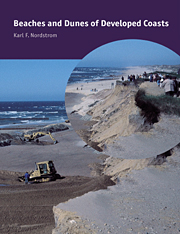Book contents
- Frontmatter
- Contents
- Preface
- Acknowledgements
- 1 The developed coastal landscape: temporal and spatial characteristics
- 2 Altering landforms to suit human needs
- 3 Replenishing landforms
- 4 Effects of structures on landforms and sediment availability
- 5 Characteristics of human-altered coastal landforms
- 6 Temporal scales of landscape change
- 7 Management programs
- 8 Maintaining and enhancing natural features in developed landscapes
- 9 Directions for geomorphological research
- References
- Index
2 - Altering landforms to suit human needs
Published online by Cambridge University Press: 18 December 2009
- Frontmatter
- Contents
- Preface
- Acknowledgements
- 1 The developed coastal landscape: temporal and spatial characteristics
- 2 Altering landforms to suit human needs
- 3 Replenishing landforms
- 4 Effects of structures on landforms and sediment availability
- 5 Characteristics of human-altered coastal landforms
- 6 Temporal scales of landscape change
- 7 Management programs
- 8 Maintaining and enhancing natural features in developed landscapes
- 9 Directions for geomorphological research
- References
- Index
Summary
Introduction
Beaches and dunes are eliminated, altered through use, reshaped, remobilized, stabilized or created to suit human needs (Table 2.1). Many of these changes are designed for multiple purposes and may involve several different kinds of human processes occurring in several stages (Pye 1990). The alterations may be intentional (where the landform is considered less suitable than the alternative) or unintentional (where people change the sediment budget or vegetation characteristics that, in turn, change locations of deposition and erosion). Some uses may be considered consumptive, in that the landform is totally eliminated from a specific location (e.g., the dunes in the background of Figure 2.1). Other uses may reshape or even create landforms, but the form and genesis of the feature will be a function of human needs.
Many alterations are designed to create one kind of landform at the same time that they destroy a different kind. As a result, it is difficult to classify human actions in mutually exclusive categories. The major headings used in this chapter are based on degree of alteration, beginning with alterations that completely eliminate landforms or prevent them from responding to natural processes by converting their surfaces to cultural features. Subheadings are based on the rationale for the alteration (in terms of resource value) that is responsible for the landscape conversion. The alterations described in this chapter are of large scale and include changes in the form and surface characteristics. Creation of new landforms and increases in their dimensions through beach and dune nourishment are assessed in chapter 3
- Type
- Chapter
- Information
- Beaches and Dunes of Developed Coasts , pp. 27 - 66Publisher: Cambridge University PressPrint publication year: 2000



